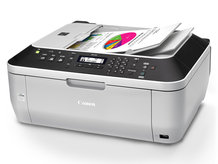Inkjet printers to help track bioweapons
Printable toxin sensors developed by Canadian scientists

Forget Glocks, helicopters and suitcases of torture instruments, 24's Jack Bauer should draft an inkjet printer into his next day's battle against terrorists.
A research team at McMaster University in Canada has come up with a way to print a toxin-detecting biosensor on paper using a Fujifilm inkjet printer.
The paper-based biosensors can detect harmful poisons that can cause food poisoning or even be used as bioterrorism agents.
Ink-credible prints
The process involves making an ink like the one found in computer printer cartridges but with special additives to make the ink biocompatible. An ink comprised of biocompatible silica nanoparticles is first deposited on paper, followed by a second ink containing a special enzyme.
The resulting bio-ink forms a thin film of enzyme that is entrapped in the silica on paper. When the enzyme is exposed to a toxin, reporter molecules in the ink change colour in a manner that is dependent on the concentration of the toxin in the sample.
The goal for bioactive paper is to provide a rapid, portable, disposable and inexpensive way of detecting harmful substances, including toxins, pathogens and viruses, without the need for sophisticated instrumentation.
Sign up to the TechRadar Pro newsletter to get all the top news, opinion, features and guidance your business needs to succeed!
Pee on a stick to see if you've got anthrax?
This new process is expected to bring the concept of bioactive paper a step closer to commercialisation, by demonstrating it working to detect poisons as easily and cheaply as today's home pregnancy tests.
The research also showed that the printed enzyme retains full activity for at least two months when stored properly, suggesting that such sensor strips should have a good shelf life.
Portable bio-sensing papers are expected to be extremely useful in monitoring environmental and food-based toxins, as well as in remote settings in less industrialised countries where such simple tests are essential for the first stages of detecting disease.